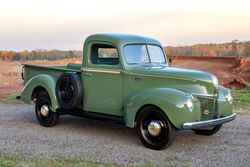
Toward the end of World War I, the U.S. economy was booming, and Ford® pickup trucks helped to usher in the new era of prosperity. These trucks were based on the highly successful Model T and were the first spark in a change of design that persists today. If you want to learn more about the history of these trucks, below is a history of their inception and various iterations.
Early Efforts
The first Ford truck was the 1917 Model TT. This model had a strengthened chassis that could support up to one ton of weight in its simple flatbed. It and its successor, the Model AA, sold well until 1934, putting trucks on millions of farms throughout the nation.
However, by 1935, Ford saw that consumers had a need for a truck that combined the company’s unique body style with robust performance. The result was the Model 50, which was a truck that could put in a full workday on the farm and was stylish enough for trips into town. By 1941, Ford had become a leading producer of pickup trucks, with all the knowledge and experience that they would need to face their next challenge.
World War II
 Ford began full wartime production after the attack on Pearl Harbor, churning out hundreds of thousands of heavy trucks to carry troops and supplies. As a result, returning servicemen had a fondness for the sturdy trucks after the war. This set the stage for Ford to introduce the iconic F-Series® trucks that it still makes today.
Ford began full wartime production after the attack on Pearl Harbor, churning out hundreds of thousands of heavy trucks to carry troops and supplies. As a result, returning servicemen had a fondness for the sturdy trucks after the war. This set the stage for Ford to introduce the iconic F-Series® trucks that it still makes today.
The first F-Series ranged from the basic F-1 to the massive F-8, capable of carrying loads heavier than two tons. With the second generation of the F-series in 1952 came less utilitarian styling, such as two-tone paint jobs, improved cab heaters, and radios. These became the classic Ford trucks that epitomized the 1950s, which are extremely popular among classic car enthusiasts.
The Modern Era
As Ford was adding streamlined bodies, expanded cabs, and bench seats to its trucks, the company changed the naming style of its models. The half-ton F-1 became the F-150, the F-2 was now the F-250, and so on. Throughout the third to ninth generations of the F-series, all of Ford’s pickup trucks were primarily utility vehicles that could also serve as daily drivers.
However, in 1996, the 10th generation drew a clear line between the heavier F-250 and F-350 models for commercial work, leaving the F-150 for enthusiasts and families. For lighter industries and urban trucking, Ford introduced the Ranger in 1983. Subsequent generations would provide better fuel efficiency, lush interiors, and trim packages for luxury enthusiasts.
If you love classic pickup trucks and want to learn more about them, subscribe to Vintage Truck Magazine. The publication has subscribers across the United States, offering reviews, manuals, tutorials, and interesting articles on vintage and antique trucks. Call (937) 767-1433 to speak with a team member. Visit them online to subscribe.
About the Business
Have a question? Ask the experts!
Send your question

